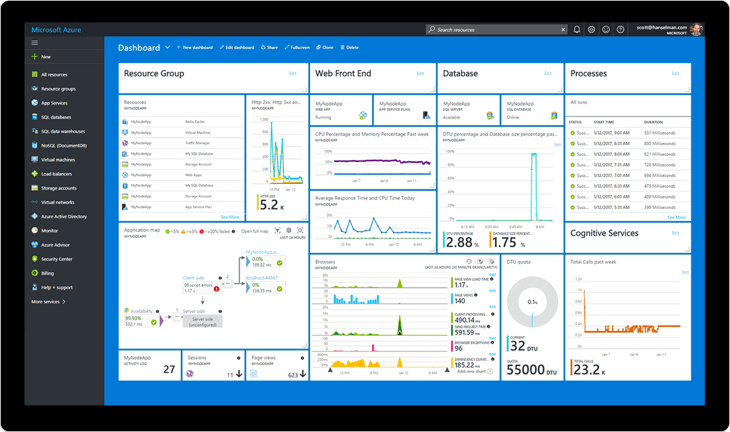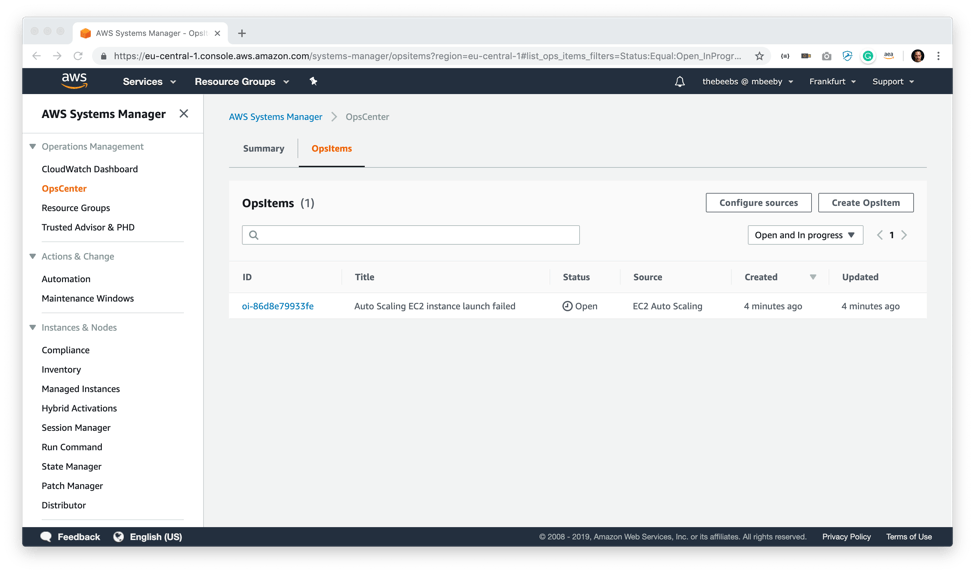Digital Transformation Services - Strategy & Framework for Company Transition
What is Digital Transformation? The term digital transformation often gets associated with buzzwords like AI, blockchain, cloud, and automatization. But what...

In this article, you’ll learn about:
But cloud technology is not a monolith. There are several platforms to choose from, which will suit you the best depending on your particular needs. While the solutions out there are quite abundant, and the two most commonly used are AWS and Azure.
As far as cloud technologies go, AWS and Azure have the biggest presence on the market. With some of the best selections of features and services, they both have a high likelihood of being compatible with most business needs.
AWS stands for Amazon Web Services, and, as the name suggests, Amazon is responsible for it. Launched in 2006, it is one of the oldest cloud platforms out there and is currently the market leader. It offers a wide range of services – over 165 of them – which are designed in a way that allows them to easily work with each other, which ensures high flexibility and efficiency. The services AWS offers are separated into three categories – IaaS (infrastructure as a service), SaaS (software as a service), as well as Paas (platform as a service). It’s definitely a versatile platform that can be easily fine-tuned to suit the needs of any business.
Azure, on the other hand, is a platform provided by Microsoft. Launched in 2010, it covers a very similar range of services as AWS, divided into the same categories of IaaS, PaaS, and SaaS. While introduced a year after AWS, it has been met with a lot of praise for its myriad features that work great together, quickly making it a worthy contender to the brand leader.
At first glance, then, it may look as if you’re choosing between two identical products. However, while there are similarities simply by virtue of these being the same type of platform, there are some key differences that will ultimately be the deciding factor for you and your business. To help you find the one that best suits your personal needs, we’ve compiled a list of all key aspects of these cloud technologies and detailed how they compare to each other.
AWS allows its users to configure their own virtual machines, use a pre-configured machine image, and customize their MIs using EC2 (Elastic Compute Cloud). There are plenty of options to choose from, with variables in terms of power, size, memory, as well as number of VMs.
Azure lets users choose a Virtual Hard Disk, which can then be used to create a VM. Users can pick between VHDs preconfigured by Microsoft or configure them on their own, or use a third party. Whichever option they choose, they must specify the desired amount of cores and memory.
AWS implements the S3 system (simple storage service) for object storage. Compared with Azure’s solution, it runs longer and offers plenty of documentation and tutorials for added ease of use. However, block storage is also available – it can be either separate or attached to an instance. Data is archived using Glacier. The temporary storage is destroyed when a particular instance is terminated. AWS also offers support for NoSQL and relational databases, as well as Big Data.
Azure’s temporary storage happens through the D drive, block storage for VMs, while object storage occurs through Block Blobs and Files. Data is archived through storage cool and storage archive. Like AWS, Azure supports relational databases, NoSQL, and Big Data through HDInsight and Azure Table.

Cloud computing platforms are less expensive, offer higher security and flexibility than on-premises servers. | Source: https://azure.microsoft.com/
AWS utilizes a virtual private cloud (VPC) for all of its networking – this allows its users to create their own isolated networks within the cloud. This involves the use of API gateways for cross-connectivity.
Azure incorporates Microsoft’s Virtual Network (VNET) – this also allows users to create isolated networks, subnets, private IP address ranges, network ranges, and route tables.
This is where the differences become really substantial. Both companies utilize a pay-as-you-go model, but while AWS charges users by the hour, Azure does so by the minute. With AWS, you have the option to pay on demand (i.e. without an upfront cost, you pay for what you use), on reservation (you can pay for 1 or 3 years with the upfront cost based on your use so far), or through a “spot” payment, wherein users can bid for extra capacity. In comparison, Azure is better suited for short-term commitments – on top of being charged by the minute, you have the option of prepaid and monthly charges.
The vast majority of cloud technology providers allow for the implementation of SQL and NoSQL databases. Here’s how AWS and Azure differ. AWS utilizes a relational database as one of its services – RDS while Dynamo DB carries out the NoSQL databases, and ElastiCache handles caching. Azure utilizes an SQL database, as well as MySQL and PostgreSQL – this covers their relational databases. Cosmos DB, on the other hand, is used for NoSQLs, while Redis Cache handles caching.

Customers are using cloud solutions to build reliable, secure and flexible applications. | Source: https://aws.amazon.com/
If you’re looking for a cloud solution that will handle open-source solutions better, you’re better off with Amazon’s solution, as AWS allows for much more open-source integrations, such as Jenkins and GitHub. Unlike Microsoft’s Azure, it also fares better with Linux servers. Meanwhile, Azure is the better option if you’re looking for a platform that will integrate better with Microsoft’s software, as they are already natively integrated with them. And while it won’t deal as well with open source software as AWS does, it can still handle some of them, such as Apache Hadoop and Red Hat Enterprise Linux.
Both solutions have their own advantages for their general user-friendliness, though which one will be better for you really depends on you. AWS offers far more features and configurable items, but it also takes some more time to master it. If you aren’t opposed to spending some time learning it, you might actually find AWS to be the more effective of the two solutions.
However, there’s something to be said about Azure’s native integration with Windows, which definitely makes it easier to use right away for most. While you’ll lose some of the customizability, you’ll break even with a system that’s much more familiar from the get-go and still gets the job done in most instances that AWS would.
AWS and Azure are both pretty incredible cloud systems, but which one will be better for you and your business really depends on what you’re looking for. In many respects, they’re similar, covering more or less the same ground regarding features, even if it uses different solutions to achieve them. The main differences lie in the pricing models, as well as the ease of use.
If you’re ready to commit for a longer time, both in the financial sense as well as just putting in the time to learn the ropes, AWS will most likely be the more rewarding system in the long run. On the other hand, if you want to get started quickly, get in right away without digging deep into unfamiliar territory, as well as have a more flexible payment system, Azure will give you all that in spades. In the end, you’re the one with the vision for your business.

What is Digital Transformation? The term digital transformation often gets associated with buzzwords like AI, blockchain, cloud, and automatization. But what...
In the following article, we’re going to discuss the different types of enterprise applications, take a closer look at the...
With great tools such as Amazon Web Services (AWS), the cloud reduces overall costs of IT and labour, limiting human error...